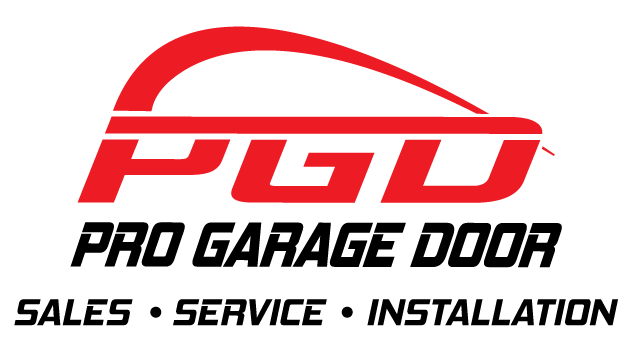Follow Us x
Rolling Service Doors
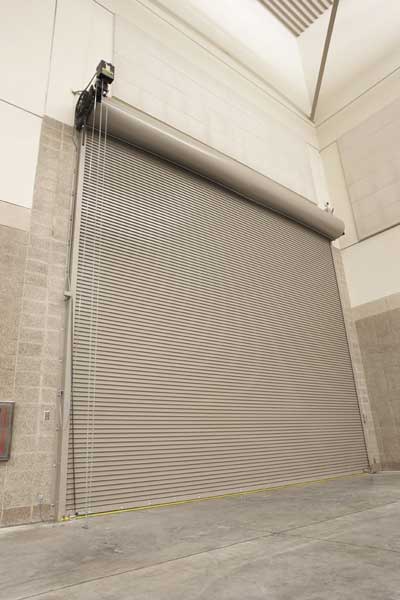 The Wayne-Dalton 800 Series rolling service door is designed to meet the tough requirements of virtually any commercial or industrial application. The 800 Series offers flexibility in substrate materials with choices of galvanized or prime steel, stainless steel, or aluminum.
The Wayne-Dalton 800 Series rolling service door is designed to meet the tough requirements of virtually any commercial or industrial application. The 800 Series offers flexibility in substrate materials with choices of galvanized or prime steel, stainless steel, or aluminum.
Color options range from our standard five factory finish colors to a full range of 180 RAL powder coat choices.
Popular in both interior and exterior applications, the Wayne-Dalton 800 Series rolling service door features a galvanized, pre-painted curtain of minimum 22-gauge steel. The 800 Series doors have a standard windload rating of 20 PSF. An optional windload rating of up to 55 PSF is available to cover your Florida and Dade County windload requirements.
Materials & Construction
Wayne-Dalton’s 800 Series rolling doors are composed of curved or flat-faced slats that provide a natural watershed, helping to reduce corrosion. The slats are designed with free-acting interlocking joints that permit easy articulation when the door coils.
The 800 Series features a strong double-angle bottom bar that reinforces the lower edge of the curtain against wind pressure and permits varied lock, astragal, and safety edge options. This bottom bar is designed for easy installation and does not require fasteners protruding into the guide openings, so the bottom bar does not interfere with door operation.
Counterbalance assembly consists of a spring barrel which serves as a load-carrying beam. It encases the counterbalance mechanism and provides the axis around which the curtain coils. (Deflection is limited to 0.033" per lineal foot of span.) If required, barrel rings of malleable iron or stamped steel may be provided to assure proper counterbalance. Oil-tempered, torsion-type counterbalance springs are wound from heat-treated steel, providing accuracy in balancing the door. Barrel plugs connect ends of springs to barrel and tension rod. Tension rod of steel shafting holds fixed ends of springs and carries torsion load of spring counterbalance.
Spring tension adjusting wheel is normally mounted outside the bracket on end of tension rod. Inside adjusting wheel for tight side-room applications is available in limited sizes.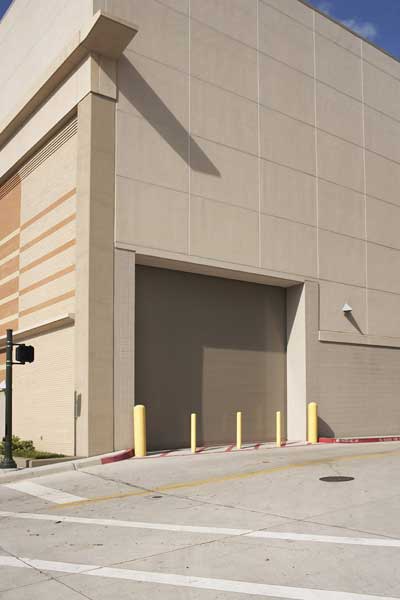 The hood covers the curtain coil and counterbalance mechanism. Slat hoods are available on blue, brown, beige, and white doors.
The hood covers the curtain coil and counterbalance mechanism. Slat hoods are available on blue, brown, beige, and white doors.
The Wayne-Dalton 800C Series rolling service door is designed to meet the tough requirements of virtually any commercial or industrial application with the added advantage of energy efficiency. The 800C Series offers flexibility in substrate materials with choices of galvanized or prime steel, stainless steel, or aluminum.
Color options range from our standard five factory finish colors to a full range of 180 RAL powder coat choices. Polyurethane insulation in each slat promotes energy savings and building comfort.
Popular in both interior and exterior applications, the Wayne-Dalton 800C Series insulated rolling service door features a galvanized, pre-painted curtain of minimum 22-gauge steel. 800C Series doors are wind load rated at 20 PSF. An optional wind load rating of up to 55 PSF is available to cover your Florida and Dade County windload requirements.
Materials & Construction
Wayne-Dalton’s 800C Series rolling doors are composed of flat slats that provide a natural watershed, helping to reduce corrosion. The slats are designed with free-acting interlocking joints that permit easy articulation when the door coils.
The 800C Series features a strong double-angle bottom bar that reinforces the lower edge of the curtain against wind pressure and permits varied lock, astragal, and safety edge options. This bottom bar is designed for easy installation and does not require fasteners protruding into the guide openings, so the bottom bar does not interfere with door operation.
Counterbalance assembly consists of a spring barrel which serves as load-carrying beam. It encases the counterbalance mechanism and provides the axis around which the curtain coils. (Deflection is limited to 0.033" per lineal foot of span.) If required, barrel rings of malleable iron or stamped steel may be provided to assure proper counterbalance. Oil-tempered, torsion-type counterbalance springs are wound from heat-treated steel, providing accuracy in balancing the door. Barrel plugs connect ends of springs to barrel and tension rod. Tension rod of steel shafting holds fixed ends of springs and carries torsion load of spring counterbalance.
Spring tension adjusting wheel is normally mounted outside the bracket on end of tension rod. Inside adjusting wheel for tight side-room applications is available in limited sizes.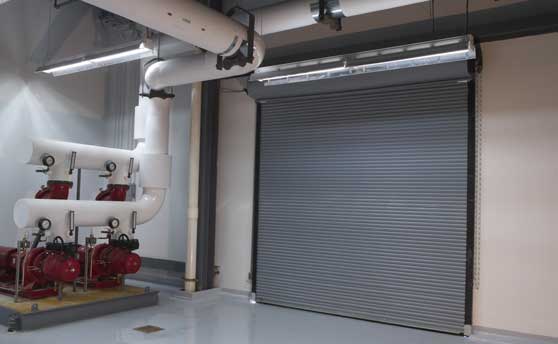 The hood cover encloses the curtain coil and counterbalance mechanism. Slat hoods are available on blue, brown, beige, and white doors.
The hood cover encloses the curtain coil and counterbalance mechanism. Slat hoods are available on blue, brown, beige, and white doors.
The Wayne-Dalton 900 Series rolling service door is ideal for jobs where an economical solution for durability and strength is needed. The 900 Series offers flexibility in substrate materials with choices of 24, 22, or 20–gauge galvanized steel, stainless steel, or aluminum.
Color options range from our five standard factory-finish colors to a full range of 180 RAL powder coat choices.
Popular in both interior and exterior applications, the Wayne-Dalton 900 Series rolling service door features a galvanized, pre-painted curtain of minimum 24-gauge steel. All 900 series doors are standard wind load rated with a minimum of 20 PSF.
Materials & Construction
Wayne-Dalton’s 900 Series rolling doors are composed of curved or flat-faced slats that provide a natural water-shed, helping to reduce corrosion. The slats are designed with free-acting interlocking joints that permit easy articulation when the door coils.
The 900 Series features a strong double-angle bottom bar that reinforces the lower edge of the curtain against wind pressure and permits varied lock, astragal and safety edge options. This bottom bar is designed for easy installation and does not require fasteners protruding into the guide openings, so the bottom bar does not interfere with door operation.
The counterbalance assembly consists of a spring barrel which serves as a load-carrying beam. It encases the counterbalance mechanism and provides the axis around which the curtain coils. (Deflection is limited to 0.033" per lineal foot of span.) If required, barrel rings of malleable iron or stamped steel may be provided to assure proper counterbalance. Oil-tempered, torsion-type counterbalance springs are wound from heat-treated steel, providing accuracy in balancing the door. Barrel plugs connect ends of springs to barrel and tension rod. Tension rod of steel shafting holds fixed ends of springs and carries torsional load of spring counterbalance.
Spring tension adjusting wheel is normally mounted outside the bracket on end of tension rod. Inside adjusting wheel for tight side-room applications is available in limited sizes.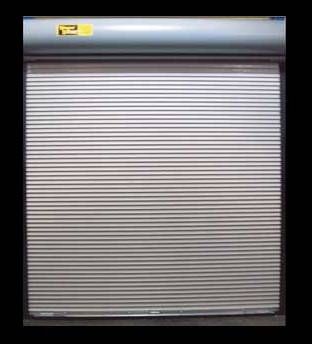 The hood cover encloses the curtain coil and counterbalance mechanism. Slat hoods are available in blue, brown, beige, and white doors.
The hood cover encloses the curtain coil and counterbalance mechanism. Slat hoods are available in blue, brown, beige, and white doors.
The Model 926 rolling steel service door provides an economical yet durable solution for self-storage to industrial openings. Yet it does not sacrifice on essential features and benefits needed in such applications.
Materials & Construction
Wayne-Dalton’s 926 Series rolling doors are composed of flat-faced slats that provide a natural water-shed, helping to reduce corrosion. The slats are designed with free-acting interlocking joints that permit easy articulation when the door coils.
The 926 Series features a strong double-angle bottom bar that reinforces the lower edge of the curtain against wind pressure and permits varied lock, astragal and safety edge options. This bottom bar is designed for easy installation and does not require fasteners protruding into the guide openings, so the bottom bar does not interfere with door operation. Zinc plated, cast iron windlocks add strength and prevent lateral slat movement.
The counterbalance assembly consists of a spring barrel which serves as a load-carrying beam. It encases the counterbalance mechanism and provides the axis around which the curtain coils. (Deflection is limited to 0.033" per lineal foot of span.) If required, barrel rings of malleable iron or stamped steel may be provided to assure proper counterbalance. Oil-tempered, torsion-type counterbalance springs are wound from ASTM A229 steel, providing accuracy in balancing the door. Barrel plugs connect ends of springs to barrel and tension rod. Tension rod of steel shafting holds fixed ends of springs and carries torsional load of spring counterbalance.
Spring tension adjusting wheel is normally mounted outside the bracket on end of tension rod. Inside adjusting wheel for tight side-room applications is available in limited sizes.
The hood cover encloses the curtain coil and counterbalance mechanism. Slat hoods are available.
